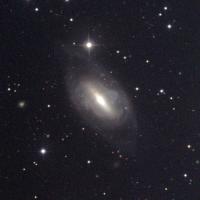![[NGC 2685, KPNO]](Pics/n2685.jpg)
Helix Galaxy, Pancake Galaxy
| Right Ascension | 8 : 55.6 (h:m) |
|---|---|
| Declination | +58 : 44 (deg:m) |
| Distance | (kly) |
| Visual brightness | 11.1 (mag) |
| Apparent dimension | 5.2 (arc min) |
NGC 2685 was discovered by Wilhelm Tempel on August 18, 1882.
NGC 2685 is an unusual lenticular galaxy of type S0(pec), sometimes also classified as SB0(pec), in the constellation Ursa Major. It shows two axes of symmetry as well as an encircling ring. Such galaxies are called polar ring galaxies, and NGC 2685 is an interesting and beautiful example. Because of its shape, it is also called the Helix Galaxy or the Pancake Galaxy. As Nigel Sharp of the NOAO describes it, this galaxy has "a set of unusual whorls, or helical filaments, surrounding the central spindle of a relatively normal S0 galaxy, and was called the most unusual galaxy in the Shapley-Ames catalogue."
The image at top right in this page was obtained with the KPNO 4-meter Mayall
telescope in 1975.
Credit: AURA/NOAO/NSF
 The image on the right is a color composite of
CCD images from the 0.9-meter telescope of the Kitt Peak National
Observatory, near Tucson, Arizona, taken in November 1998. Image size is 8.5
arc minutes square.
The image on the right is a color composite of
CCD images from the 0.9-meter telescope of the Kitt Peak National
Observatory, near Tucson, Arizona, taken in November 1998. Image size is 8.5
arc minutes square.
Physically, the polar rings are composed of stars and interstellar matter, i.e., gas and dust, and were probably generated by gravitational interaction, i.e., torn apart from smaller galaxies which happened to come too close to the larger "mother" galaxy, sometimes up to a complete merger with the small galaxy.
Halton Arp has included NGC 2685 as No. 336 in his Atlas of Peculiar Galaxies.